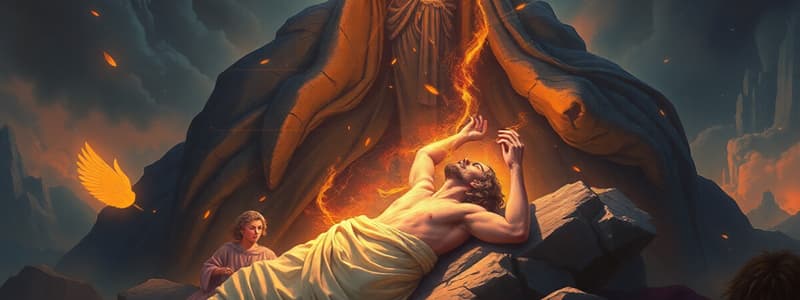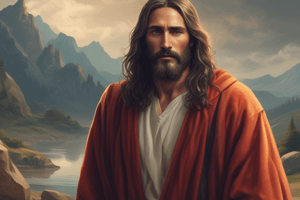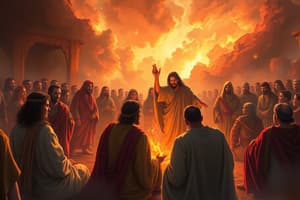Podcast
Questions and Answers
What psychological change was observed in the disciples after the resurrection?
What psychological change was observed in the disciples after the resurrection?
- They began avoiding confrontation with authorities.
- They showed a change from fear to bold preaching. (correct)
- They became more secretive about their beliefs.
- They sought to distance themselves from each other.
What historical pieces of evidence support the belief in the resurrection?
What historical pieces of evidence support the belief in the resurrection?
- Multiple independent sources including early accounts like Mark and Paul's epistles. (correct)
- Josephus exclusively.
- Only the testimonies of disciples.
- The Gospel of John alone.
What role did Joseph of Arimathea play that adds credibility to the empty tomb story?
What role did Joseph of Arimathea play that adds credibility to the empty tomb story?
- He lived far from Jerusalem.
- He was a close disciple of Jesus.
- He was a known criminal.
- His court position made him unlikely to invent the story. (correct)
What cultural factor made the women's discovery of the empty tomb significant?
What cultural factor made the women's discovery of the empty tomb significant?
Which competing theory hypothesizes that the resurrection was merely a product of mass hallucinations?
Which competing theory hypothesizes that the resurrection was merely a product of mass hallucinations?
What was a major problem with the swoon theory regarding Jesus' survival?
What was a major problem with the swoon theory regarding Jesus' survival?
What does the resurrection theory best explain according to the evidence presented?
What does the resurrection theory best explain according to the evidence presented?
What confirmed the physical interactions of the resurrected Jesus as described in the accounts?
What confirmed the physical interactions of the resurrected Jesus as described in the accounts?
Which of the following identified a problem with the stolen body theory?
Which of the following identified a problem with the stolen body theory?
What was a significant outcome noted among the apostles after the resurrection?
What was a significant outcome noted among the apostles after the resurrection?
Flashcards
Death Confirmation
Death Confirmation
Medical and historical evidence that Jesus had indeed died.
Empty Tomb
Empty Tomb
Accounts report that Jesus' tomb was found empty by women.
Joseph of Arimathea
Joseph of Arimathea
A prominent figure who provided the tomb and verified claims.
Women Discoverers
Women Discoverers
Signup and view all the flashcards
Jewish Leaders' Acknowledgement
Jewish Leaders' Acknowledgement
Signup and view all the flashcards
Post-Resurrection Appearances
Post-Resurrection Appearances
Signup and view all the flashcards
Transformation of Disciples
Transformation of Disciples
Signup and view all the flashcards
Horrific Conditions
Horrific Conditions
Signup and view all the flashcards
Competing Theories
Competing Theories
Signup and view all the flashcards
Resurrection Theory
Resurrection Theory
Signup and view all the flashcards
Study Notes
Death of Jesus
- Medical evidence from a 1986 JAMA study confirmed death prior to removal from the cross.
- Roman soldiers were skilled at executions.
- Gospel accounts describe blood and water, providing physical evidence.
- Non-Christian sources verify Jesus' death.
- Josephus confirmed Jesus' death and reported the resurrection.
- Early Jewish responses accepted Jesus' death as a fact.
Empty Tomb
- Paul's 1 Corinthians 15 creed, written shortly after the events, documents the empty tomb.
- Mark's account (AD 42-56) and other independent accounts (Matthew, Mark, Luke, and John) support the empty tomb.
- Joseph of Arimathea, a known and respected figure, provided his own tomb, making Christian invention less likely.
- Women's testimony was culturally undervalued and would not be invented due to social status.
- Jewish leaders acknowledged the empty tomb, proposing theories to explain it but never produced a body to counter claims.
Resurrection Appearances
- 1 Corinthians 15 details the chronological order: Peter, then disciples, a large gathering of more than 500, James (Jesus' brother), and Paul.
- Appearances lasted 40 days.
- Physical contact was reported, including shared meals and physical presence in various locations and circumstances.
- Cyril's historical accounts, gospel narratives, Paul's epistles, and the Emmaus Road incident confirm appearances.
- Physical interaction, such as touching and shared meals, were noted.
Transformation of Disciples
- Disciples went from fear and hiding to bold public preaching.
- Willingness to face persecution and death.
- A complete reversal of behavior exemplifies this transformation.
- Peter, from a denier to a leader.
- James' conversion (from skepticism to belief).
- Paul's dramatic change from persecutor to follower.
- Willingness to face martyrdom for their beliefs.
- Crucial difference from modern martyrs—knew if it was true or not.
Horrific Conditions and Opposition
- Severe persecution, ostracism, hardship, and torture characterized the early Christian life.
- Jewish religious authorities, Roman political pressure, and social stigma were prominent opposing forces.
- Family rejection was also a hardship for believers.
Summary of Competing Theories and Problems
- Conspiracy/Stolen Body Theory: Problems include the Roman guard presence, unexplained disciple transformation, lack of motive for martyrdom, and unexplainable physical appearances.
- Swoon Theory: Problems include the impossibility of survival with crucifixion, moving a stone in a weakened state, lack of quick recovery, Roman execution expertise, and difficulty explaining post-resurrection influence.
- Wrong Tomb Theory: Problems include the authorities' ability to verify the correct tomb, multiple people knowing its location, failure to explain appearances and Joseph of Arimathea's testimony, and ease of disproof.
- Hallucination Theory: Problems include the unprecedented nature of mass hallucinations, reported physical interactions, unexplained empty tomb, occurrences in diverse times and places, and various witnesses.
- Disciples Lied Theory: Problems include lack of motive for disciples' suffering, ease of disproving lies, unexplained transformation, multiple independent accounts, and confirmation from non-Christian sources.
Conclusion
- The resurrection theory addresses all evidence categories and explains both physical and psychological elements.
- It aligns with historical documents, earliest Christian beliefs, and the transformation of the disciples.
- Provides an explanation of willing martyrdom, empty tomb, and appearances, fitting the documented evidence.
Studying That Suits You
Use AI to generate personalized quizzes and flashcards to suit your learning preferences.




